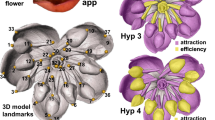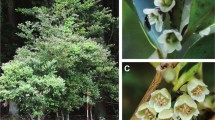Abstract
FLORAL longevity, the length of time a flower remains open and functional, varies among plant species. Flowers of some species live less than one day (morning glory), whereas others live for several weeks (orchids)1–3. By viewing floral longevity as a resource allocation strategy2,4, we now incorporate the study of its evolution into the well developed theoretical framework provided by evolu-tionarily stable strategy models that address variation in life history5,6. Flowers must remain open to contribute to plant fitness through ovule fertilization and pollen dissemination, when they require resources for respiratory maintenance and pollinator attraction. Accordingly, floral senescence should occur when the expected fitness gain per unit of floral maintenance investment diminishes to the point where it becomes more profitable to construct a new flower than to maintain an existing one. Our experimental evidence supports floral longevity as an adaptation that balances rates of pollen receipt and removal against the cost of floral maintenance.
This is a preview of subscription content, access via your institution
Access options
Subscribe to this journal
Receive 51 print issues and online access
$199.00 per year
only $3.90 per issue
Buy this article
- Purchase on Springer Link
- Instant access to full article PDF
Prices may be subject to local taxes which are calculated during checkout
Similar content being viewed by others
References
Kerner Von Marilaun, A. The Natural History of Plants, Their Forms, Growth and Distribution (Holt, New York, 1895).
Primack, R. B. A. Rev. Ecol. Syst. 16, 15–37 (1985).
Ashman, T.-L. & Schoen, D. J. in Floral Biology (eds Lloyd, D. G. & Barrett, S. C. H.) (Chapman and Hall, New York, in the press).
Schoen, D. J. & Ashman, T.-L. Evolution (in the press).
Charnov, E. L. The Theory of Sex Allocation (Princeton Univ. Press, Princeton, 1982).
Stearns, S. C. The Evolution of Life Histories (Oxford Univ. Press, Oxford, 1992).
Nobel, P. S. Bot. Gaz. 138, 1–6 (1977).
Van der Pijl, L. & Dodson, C. H. Orchid Flowers: Their Pollination and Evolution (Univ. of Miami Press, Coral Gables, 1966).
Chabot, B. F. & Hicks, D. J. A. Rev. Ecol. Sys. 13, 229–259 (1982).
Kikuzawa, K. Am. Nat. 138, 1250–1263 (1991).
Ackerly, D. D. thesis, Harvard Univ. (1993).
Kasmer, J. M. Bull. Ecol. Soc. Amer. 74, 302 (1993).
Miller, R.B. Am. J. Bot. 65, 406–414 (1978).
Gerber, M. A. Ecology 66, 762–772 (1985).
Williams, K., Field, C. B., & Mooney, H. A. Am. Nat. 133, 198–211 (1989).
Chapin, F. S. Am. Nat. 133, 1–19 (1989).
Lovett-Doust, J. & Harper, J. L. New Phytol. 85, 251–264 (1980).
Ashman, T.-L. & Baker, I. Ecology 73, 1237–1243 (1992).
Nesom, G. L. & La Duke, J. C. Can. J. Bot. 63, 7–14 (1985).
Lubbers, A. E. & Lechowicz, M. J. Ecology 70, 85–96 (1989).
Maynard Smith, J. Evolution and the Theory of Games (Cambridge Univ. Press, Cambridge, 1982).
Wilkinson, L. SYSTAT (SYSTAT Inc., Evanston, 1990).
Effron, B. An Introduction to the Bootstrap. (Chapman and Hall, New York, 1993).
Author information
Authors and Affiliations
Rights and permissions
About this article
Cite this article
Ashman, TL., Schoen, D. How long should flowers live?. Nature 371, 788–791 (1994). https://doi.org/10.1038/371788a0
Received:
Accepted:
Issue Date:
DOI: https://doi.org/10.1038/371788a0
This article is cited by
-
Reproductive biology of an endangered lithophytic shrub and implications for its conservation
BMC Plant Biology (2022)
-
Range expansion decreases the reproductive fitness of Gentiana officinalis (Gentianaceae)
Scientific Reports (2022)
-
Pollination-associated shortening of the functional flower lifespan in an alpine species of Alstroemeria and the water content of flowers
Alpine Botany (2022)
-
Diversity increases yield but reduces harvest index in crop mixtures
Nature Plants (2021)
-
Phenological variation of flower longevity and duration of sex phases in a protandrous alpine plant: potential causes and fitness significance
BMC Plant Biology (2020)
Comments
By submitting a comment you agree to abide by our Terms and Community Guidelines. If you find something abusive or that does not comply with our terms or guidelines please flag it as inappropriate.



